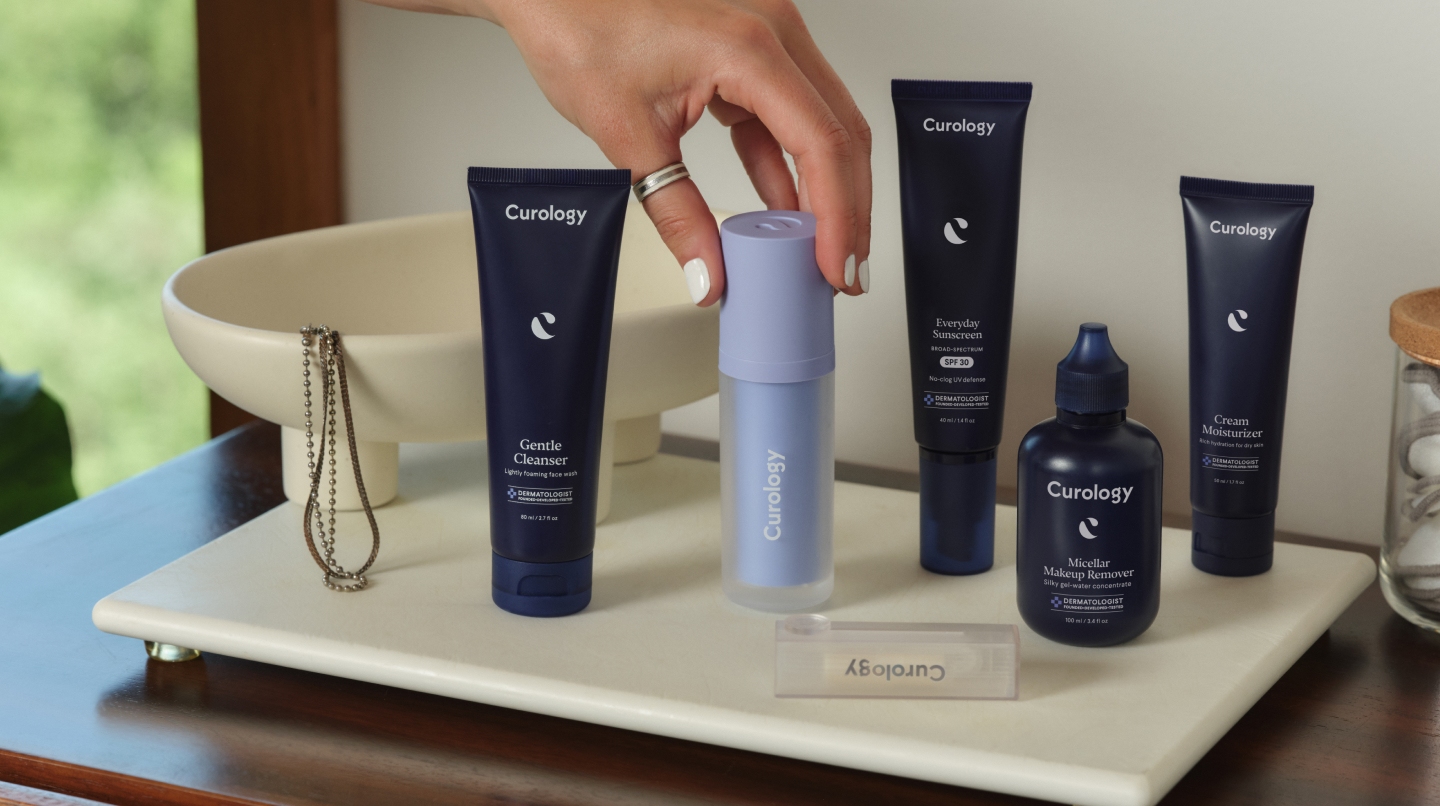How it works:
Share your skin goals and snap selfies
Your dermatology provider prescribes your formula
Apply nightly for happy, healthy skin
How it works:
How it works:
Share your skin goals and snap selfies
Your dermatology provider prescribes your formula
Apply nightly for happy, healthy skin
How it works:
Does greasy food cause acne?
The link between acne and your favorite fried foods.



Fried foods: They’re delicious but maybe not so nutritious. Used across the world by restaurants, fast-food chains, and home cooks, deep-frying is quick and affordable. It involves battering foods before submerging them in large quantities of boiling oil. Your favorite French fries, chips, corn dogs, cheese sticks, chicken strips, and more? Yep, they’re probably deep-fried!
Compared to other cooking methods, deep-frying adds calories and trans fats, meaning these foods may negatively impact your overall health. But does greasy food cause acne? Here we’ll discuss the possible link between fried foods and breakouts to determine whether it’s worth skipping the oil.

Does fried food cause acne?
Wondering how to prevent acne? The relationship between your diet and acne is complicated. Although there’s no acne-free diet, it can’t hurt to take a closer look at what’s been on the menu lately if you’re breaking out.
While the frying process itself is not known to worsen or trigger acne, research shows a potential link between eating foods with a high glycemic index (high-carb food that raises blood glucose levels) and acne.¹ Fried foods are typically high glycemic index (GI) foods, which can exacerbate acne for some people. Findings from some studies suggest that following a low GI diet may reduce the amount of acne you have.² Low-glycemic foods include most vegetables, some fruits, beans, and steel-cut oats.
It’s important to remember that everyone is different, and although some people may have breakouts that are linked to eating fried foods, chocolate, dairy products (including skimmed milk)³ and sugar, not everyone will be affected in the same way. Many different factors can contribute to acne, and eating greasy food may (or may not) play a role.

Does greasy food affect your skin?
The insistence that a greasy diet leads to greasy skin may stem from the old adage, “You are what you eat.” The truth is the fat in your diet doesn’t directly produce the oil that develops on your skin. This oil results from excess sebum production, not excess oil consumption.
Acne is, in part, characterized by enhanced sebum production.⁴ Your skin’s excess sebum production is more likely motivated by hormones and other factors than by what you’re eating. What a relief, right? Hormonal changes play a significant role in the amount of oil your skin creates, which is why teenagers and young adults often have oily skin.⁵ Testosterone, in particular, stimulates the skin’s oil glands. This hormonal oiliness may clog pores, which contributes to pimples.⁶

Which oils are recommended to use more often?
When it comes to fried foods, the type of oil matters. Some are healthier than others, based on the types of fat they contain. Monounsaturated and polyunsaturated fats are considered healthier than saturated and trans fats. The following oils contain primarily “good” fats and are better suited for deep-frying:
Olive oil: Olive oil contains monounsaturated fats, which makes it stable for high-temperature cooking.
Avocado oil: Similar to olive oil, avocado oil has a high heat tolerance.
Peanut oil: Another oil with a high heat tolerance, peanut oil is odorless when refined. Its saturated fatty acid content is relatively stable compared to other oils.
Safflower oil: Safflower oil can withstand higher cooking temperatures than many other oils, making it ideal for deep-frying.
Sesame oil: Refined sesame oil has a high smoke point and a relatively neutral flavor that is often used to saute meats and vegetables, or is added to dressings and marinades.
Soybean oil: Soybean oil is another oil with a high smoke point used for deep-frying, baking and roasting. It’s comprised of polyunsaturated fatty acids, which are a heart-healthy type of fat that’s associated with several health benefits.⁷
Sunflower oil: A great source of vitamin E, sunflower oil is perfect for shallow frying.
Oils that are recommended to use less often in cooking include the following:
Coconut oil: More than 90% of the fatty acid in this oil is saturated, and high levels of saturated fat are not recommended for a healthy diet. That said, coconut oil is heat-resistant and maintains its quality over long periods of continuous deep-frying.⁸
Lard: An animal fat, lard is another option that’s high in saturated fat, making it a less healthy option than other oils.
Palm oil: Palm oil is made from the fruit of the oil palm tree and is a significant driver of deforestation around the world.⁹ It also contains high amounts of saturated fat, making it a less-than-stellar choice.
Side effects of eating greasy food
As tasty as they can be, fried foods are typically high in trans fats and calories. Research shows that regularly eating these foods is, unfortunately, linked to certain health issues. We’re not here to advise you to completely avoid these foods, but consider talking to your healthcare provider for guidance if you want to learn more about nutrition or make beneficial dietary changes.
Regularly eating greasy food has been linked to a greater risk of the following conditions and chronic diseases:
Heart disease: Fried foods may contribute to risk factors for heart disease, including hypertension and obesity.¹⁰ One study found that individuals who ate fried food more often were at moderately greater risk of developing heart disease, but more research is needed.¹¹
Diabetes: Fried food consumption is linked to a higher risk of developing type 2 diabetes.¹² Fast food, in particular, was found to potentially cause insulin resistance when eaten more than twice per week.¹³
Obesity: Fried foods are high in calories, and eating them significantly increases your caloric intake. Over time, this can lead to obesity, which itself is a risk factor for conditions such as heart disease and diabetes.
Curology is here to help

It can be tough to narrow down what triggers your acne breakouts and find effective treatments. Curology was founded by dermatologists to bring accessible skincare to all—we help take the guesswork out of your skincare routine. Our licensed dermatology providers will work with you to examine your skin, assess your skincare goals, and provide custom treatment options tailored to your needs.
Signing up is easy. Just answer a few questions and snap a few selfies to help us get to know your skin better. If Curology is right for you, an in-house dermatology provider will create a personalized prescription formula that targets your specific skin goals.* They’re always available to answer any skincare questions you may have and modify your formula if necessary as your skin’s needs naturally shift over time.
FAQs
While the frying process itself is not known to worsen or trigger acne, research shows a potential link between eating foods with a high glycemic index (high-carb food that raises blood glucose levels) and acne.
The insistence that a greasy diet leads to greasy skin may stem from the old adage, “You are what you eat.” The truth is the fat in your diet doesn’t directly produce the oil that develops on your skin. This oil results from excess sebum production, not excess oil consumption.
Olive oil
Avocado oil
Peanut oil
Safflower oil
Sesame oil
Soybean oil
Sunflower oil
Heart disease
Diabetes
Obesity
P.S. We did the homework so you don’t have to:
Mahmood, S., et al. Diet and acne update: Carbohydrates emerge as the main culprit.Journal of Drugs in Dermatology. (April 2014).
Baldwin H, Tan J. Effects of Diet on Acne and Its Response to Treatment.Am J Clin Dermatol. (January 2021).
Webster, G., Commentary: Diet and acne. Journal of the American Academy of Dermatology. (2008).
Zaenglein AL, Pathy AL, et al. Guidelines of care for the management of acne vulgaris.J Am Acad Dermatol. (May 2016).
Endly DC, Miller RA. Oily Skin: A review of Treatment Options.J Clin Aesthet Dermatol. (August 2017).
Sutaria AH, Masood S, et al. Acne Vulgaris.StatPearls. (August 2001).
Clemente TE, Cahoon EB. Soybean oil: genetic approaches for modification of functionality and total content.Plant Physiol. (November 2009).
Srivastava, Y., Semwal, AD., A study on monitoring of frying performance and oxidative stability of virgin coconut oil (VCO) during continuous/prolonged deep fat frying process using chemical and FTIR spectroscopy. J Food Sci Technol. (2015).
Cisneros, Elías, et al. Palm oil and the politics of deforestation in Indonesia.Journal of Environmental Economics and Management. (2021).
Gadiraju TV, Patel Y, Gaziano JM, Djoussé L. Fried Food Consumption and Cardiovascular Health: A Review of Current Evidence. Nutrients. (2015).
Cahill LE, et al, Fried-food consumption and risk of type 2 diabetes and coronary artery disease: a prospective study in 2 cohorts of US women and men. Am J Clin Nutr. (2014).
Krishnan S, Coogan PF, Boggs DA, Rosenberg L, Palmer JR. Consumption of restaurant foods and incidence of type 2 diabetes in African American women. Am J Clin Nutr. (2010).
Pereira MA, Kartashov AI, Ebbeling CB, Van Horn L, Slattery ML, Jacobs DR Jr, Ludwig DS. Fast-food habits, weight gain, and insulin resistance (the CARDIA study): 15-year prospective analysis. Lancet. (2005).
* Subject to consultation.

Curology Team

Donna McIntyre, NP-BC
Related Articles
How to use acne body wash correctly: Your straightforward guideWhy Curology is cruelty-free and vegan-friendlyWhat should your underarm care routine look like?Your 2023 skincare horoscopeWhy am I still breaking out with a good skincare routine? Experts explainPopular Articles
Ask Curology: Is my cold breaking me out?Slugging: The dermatologist-approved skincare hack going viral on TikTokTretinoin vs retinol: What’s the difference?How to create a self-care routine that actually sticksYour 2023 skincare horoscopeTry prescription skincare
Get routine essentials

Good skin days ahead
- Breakouts
- Redness
- Fine lines
- Dark spots
- Hair thinning